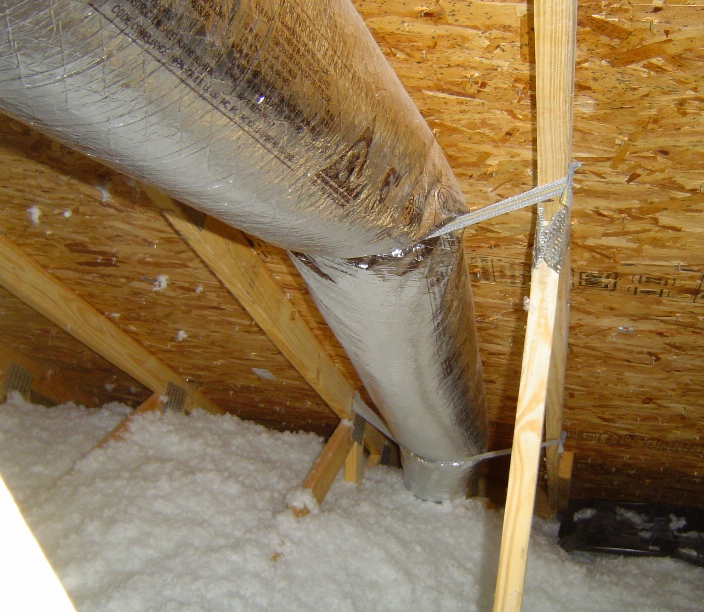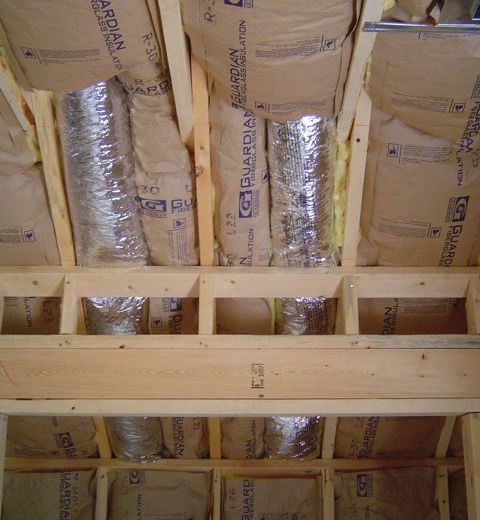Keep Out! – One Place NEVER to Put HVAC System Ducts

I had lunch yesterday with a friend who’s an HVAC designer and home energy rater in North Carolina, and he mentioned the idea of separating HVAC design from HVAC contractors. For that to happen, though, HVAC contractors first have to start doing the design part because most residential HVAC systems are thrown in with little to no actual design work.
Here’s an excellent example. See that photo above? Do you know what’s terribly wrong about installing ducts like that? Let’s leave aside the issue of whether flex duct should be used or not. What you see here would be bad even if it were rigid sheet metal ducts.
Here’s another one.

The insulation should provide the clue you need. Those ducts are going through a vaulted ceiling, and, just as a vaulted ceiling is a terrible place to put recessed can lights, it’s also perhaps the worst place you can put a duct for your HVAC system.
Not only does the duct displace insulation, it’s also right up against the roof deck. In the summer, that roof deck can get up to 150° F or higher. Inside the duct is air that should be about 55° F. That’s a 95° F temperature difference, and all that lies between that hot roof deck and the cool air is, in this case, a little bit of fiberglass insulation with an R-value of 6. Do you think that air’s going to come out of the vent at 55° F? In the winter, you’ve got warm air in the duct next to a cold roof deck, and the temperature differences can be similarly large.
Point for third party HVAC design. Yes, there are a few HVAC contractors out there who do good work, but overall, the HVAC industry needs an overhaul. I’ve talked a lot about how difficult the HVAC part will be. In fact, it may not work without third party HVAC design.
If you’re looking for solid HVAC design done by a third party that does it right, you’ve found it. We do that.
This Post Has 13 Comments
Comments are closed.

Allison,
Allison,
FYI – In NC, it’s been R-8 insulation in attics for about 6 years.
As if that’s going to make a big difference!
By the way, I’ve seen it installed that way with black flex!
As Joe would say “How stupid can you get?”
John: This
John: This house was in SC about 4 years ago and had R-6. I think we’ve had R-8 in attics for about 3 or 4 years now here in Georgia. Yeah, using black flex makes this even stupider.
Dan: Thanks. I just wish the installers would think about those numbers before they put put ducts up against a roof deck.
Thanks Allison for yet
Thanks Allison for yet another great example of bad, and all too common, practice. I would add attics to the list of places never to put duct systems (see http://www.nrel.gov/docs/fy10osti/48163.pdf).
While I agree that getting HVAC contractors to do the design part is a step in the right direction, a complete solution requires integrated design. HVAC system designers/contractors need to work with the building designers to ensure sufficient space for the duct system is provided inside the building enclosure.
Dave: You
Dave: You’re absolutely right. An attic is no place for ducts. And thanks for the article! (For anyone who doesn’t want to cut and paste, you can download Dave’s article about ducts in attics here.)
You’re also absolutely right about integrated design, and…ahem…we do that. Our architect has been doing a lot of HVAC design over the past year and now really understands how to design a house in a way that accommodates a high performance HVAC system. I put a little note at the end of the article about that with links to our pages for those services.
Don’t forget exhaust fan
Don’t forget exhaust fan ducts on the roof deck. I use data loggers and the thermal syphoning from a cold roof deck will make the bathroom seem like an outhouse. I logged one system where four 6″ ducts in a vaulted ceiling backfilled the whole HVAC system with 44F air ( it was 30F outside) in about 10 minutes.
George:
George: Great point. Ducts against the roof deck cause problems even when there’s no air being forced through them intentionally.
Similarly, burying ducts in
Similarly, burying ducts in the ceiling insulation is stupid. Fortunately, many jurisdictions don’t allow this practice, requiring ducts to be supported above the insulation.
Ideally, attic ducts should be supported just above insulation. However, some contractors make life easier by using an upflow air handler, with ducts hung from rafters at hottest point. Go figure.
Yeah, and if the duct is
Yeah, and if the duct is against the roof deck,or even the vent chutes, they are likely to get punctured with roofing nails. Insulation crammed around them makes it even more likely when sheetrock is installed & compresses the whole mess!
David:
David: Since I know you, I know that when you say, ‘Ideally, attic ducts should be supported just above insulation,’ you really meant, ‘Ideally, ducts should be inside the building envelope, but if they’re going in the attic despite research like the paper that Dave Roberts wrote, the best place to put them is just above the insulation.’ Right?
Dan: Another great point, literally! (Actually, many of them.)
Thanks Allison for the great
Thanks Allison for the great article. I couldn’t agree more and I know your friend Ken Fonorow would agree too!!
Thanks to EVER, I am slowly moving people in this area to see the great value in having a properly designed system. Thanks needs to go to Chris and David Butler too for all the great information and mentoring he has done!
The fact that the most important component of the ‘system’ that controls comfort, durability, energy efficiency and health is just thrown together and treated like a side-thought is a sad reality that must change. I hope, and believe, we are on our way toward better building practices through design and then the most important part of all – testing and verification!!
Allison, you know me well! In
Allison, you know me well! In fact, I tell builders and designers that putting HVAC/ducts inside the conditioned space is usually the single most important design decision they can make from an energy performance perspective. Now with the NREL paper, I can show them the data in a concise presentation. Thanks Dave!
David: Glad you found the
David: Glad you found the paper useful. We tried to present the info in an understandable way. Please spread it around… we shall overcome!
Jamie:
Jamie: Glad you liked the article. We have to keep plugging away at this, and eventually the tide will turn. There are a few good, conscientious HVAC contractors out there already, so we need to identify them and support them as much as possible. As we keep hammering away at these ideas and showing people the results, things will change.
David & Dave: Yep. That paper’s a great resource. I’m going to dedicate a post to it next week here in the blog and have been putting it out on Twitter and Facebook today. Thanks, Dave!